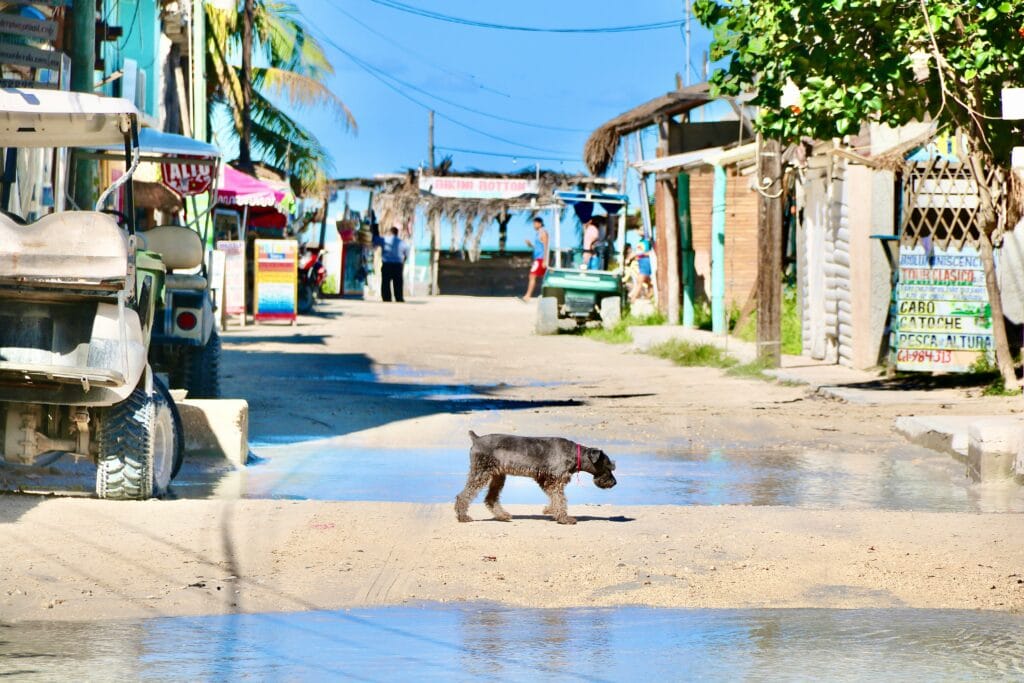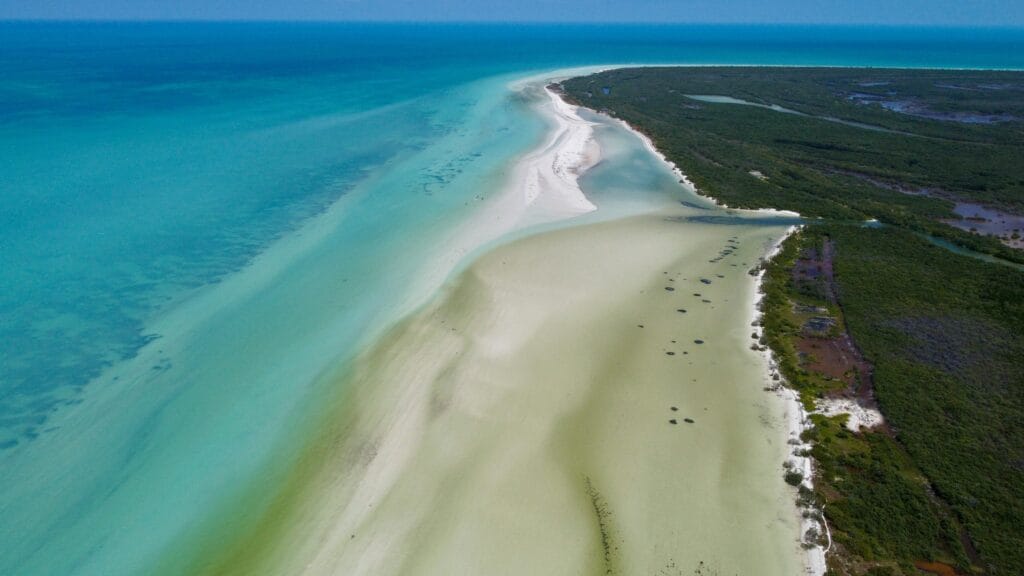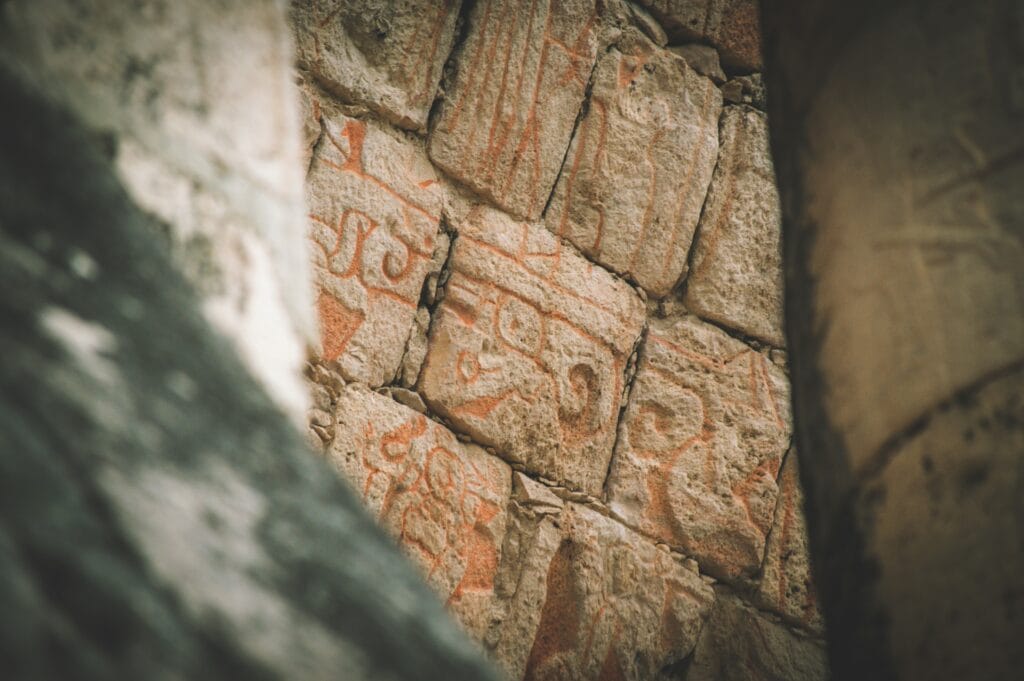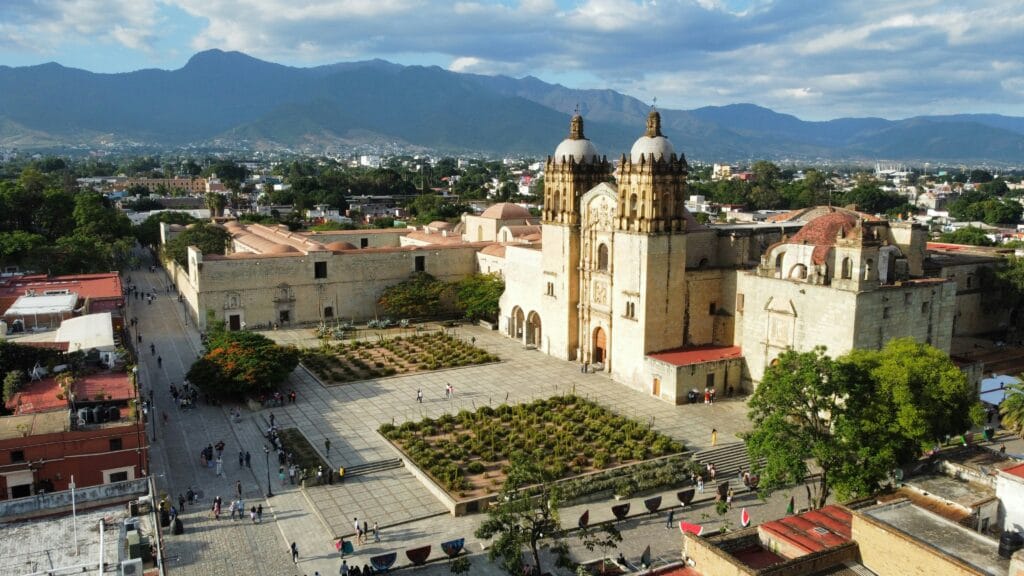A car-free island at the northern tip of the Yucatán Peninsula where flamingos outnumber tourists and the pace of life moves with the tides
The golf cart putters to a stop on Holbox’s sandy main street, and suddenly the modern world feels impossibly distant. No paved roads disturb this 26-mile stretch of sand and mangrove, no high-rises pierce the horizon, and no car engines drown out the sound of waves lapping against the shore. Here, on this slender barrier island where the Gulf of Mexico meets the Caribbean Sea, time operates on a different frequency entirely.
Isla Holbox—pronounced “HOLE-bosh,” from the Mayan words meaning “black hole”—remains one of the Yucatán Peninsula’s most authentic destinations, a place where fishing families have lived for generations and where development has been kept deliberately small-scale. While Cancún and Playa del Carmen race toward ever-greater heights of tourism, Holbox maintains its commitment to simplicity, sustainability, and the kind of unhurried living that Mexico does best.
The Rhythm of Island Life
Dawn arrives softly on Holbox, painted in watercolor pastels across an endless sky. Local fishermen have already been at sea for hours, their small boats dotting the horizon as they work the rich waters where two seas converge. By the time most visitors emerge from their hammocks, the day’s catch is already being sorted on the beach, and the island’s handful of restaurants are planning their fresh fish specials.
The absence of cars creates an intimacy with place that’s increasingly rare in our connected world. Streets of packed sand wind between colorful wooden houses raised on stilts, their walls decorated with murals that tell stories of Mayan heritage, marine conservation, and island dreams. Golf carts and bicycles provide the only motorized transport, while many visitors simply walk, discovering hidden cenotes, secluded beaches, and neighborhoods where children play in front yards that blend seamlessly with the Caribbean.
The transformation happens gradually but inevitably. Visitors arrive checking their phones constantly, worried about schedules and connections. Within days, they’re walking at the speed of the island, noticing birds they’ve never seen, tasting foods they’ve never tried. The island grants permission to live at a different pace—one where afternoon siestas aren’t laziness but wisdom, where conversations unfold without urgency, and where the day’s greatest achievement might be witnessing a perfect sunset.
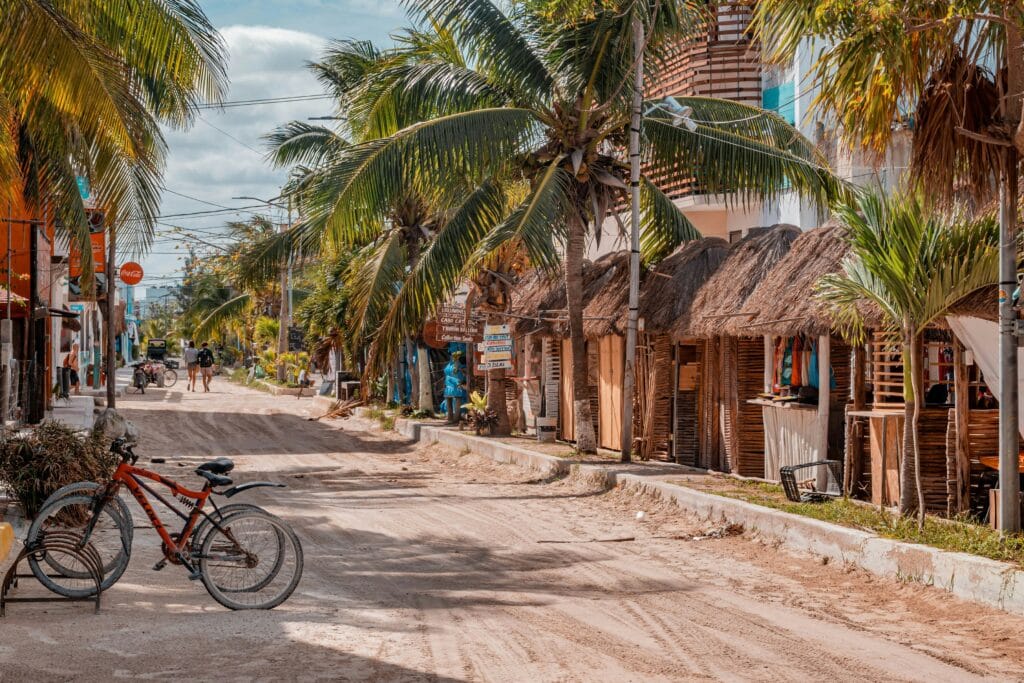
Where Flamingos Dance and Whale Sharks Glide
Holbox sits within the Yum Balam Nature Reserve, a protected area that encompasses some of the Yucatán’s most biodiverse ecosystems. The island serves as a crucial breeding ground for over 150 bird species, including the Caribbean flamingos that wade through shallow lagoons in elegant pink formations. These aren’t zoo specimens performing for cameras—they’re wild birds living as they have for millennia, creating one of North America’s most spectacular natural displays.
From June through September, Holbox becomes a gateway to one of the ocean’s most gentle giants. Whale sharks, the world’s largest fish, congregate in the nutrient-rich waters off the island’s coast, creating what marine biologists consider one of the planet’s most reliable whale shark encounters. Local guides, many of whom grew up fishing these waters, lead small-group excursions that prioritize the animals’ well-being over tourist volume.
The island’s commitment to sustainable tourism extends throughout its marine environment. Strict regulations limit the number of boats that can visit whale shark areas each day, and local guides receive ongoing training in marine conservation. Many are certified through Mexico’s National Commission of Protected Areas, bringing both traditional knowledge and modern conservation science to their work.

Authentic Flavors of the Yucatecan Coast
Holbox’s culinary scene reflects its geography and history—a blend of Mayan traditions, Caribbean influences, and the kind of brilliant improvisation that comes from island living. Here, ceviche isn’t just a dish; it’s a daily celebration of the morning’s catch, prepared with lime juice so fresh it was picked from trees growing behind the kitchen.
Local restaurants operate on island time, opening when the fish arrives and closing when the last guest has lingered over their final mezcal. At family-run establishments like Luuma or Raices Beach Club, menus change based on what the fishermen bring in and what produce arrives on the daily ferry from the mainland. This isn’t inconvenience—it’s authenticity, the kind of connection between land, sea, and table that industrial tourism destinations have long since abandoned.
The island’s signature dish, lobster pizza, might sound like fusion cuisine gone wrong, but it represents something deeper—the creativity that emerges when communities adapt global influences to local ingredients and traditions. Topped with fresh Caribbean lobster, local cheese, and herbs that grow wild on the island, it’s become a symbol of Holbox’s ability to honor its roots while embracing change thoughtfully.
Slow Travel Done Right
Holbox rewards visitors who resist the urge to pack every moment with activities. The island’s magic reveals itself gradually—in early morning walks when the beach belongs entirely to sandpipers and hermit crabs, in afternoon siestas when the Caribbean breeze makes hammocks irresistible, in evening conversations with locals who share stories passed down through generations of island living.
The lack of large-scale tourism infrastructure isn’t an oversight—it’s intentional. The island community has actively resisted mega-resort development, instead fostering small-scale accommodations that integrate with rather than dominate the landscape. Boutique hotels like Casa Las Tortugas and Ser Casasandra offer luxury that feels organic to the setting, with architectural styles that echo local traditions and sustainability practices that protect the fragile ecosystem.
Many visitors discover that Holbox’s greatest luxury is time itself—unscheduled hours to watch clouds form and dissolve, to learn a few words of Mayan from elderly residents, to understand that not every experience needs to be photographed and shared. The island operates as a gentle antidote to the overstimulation of modern travel, offering instead the profound satisfaction of presence and connection.
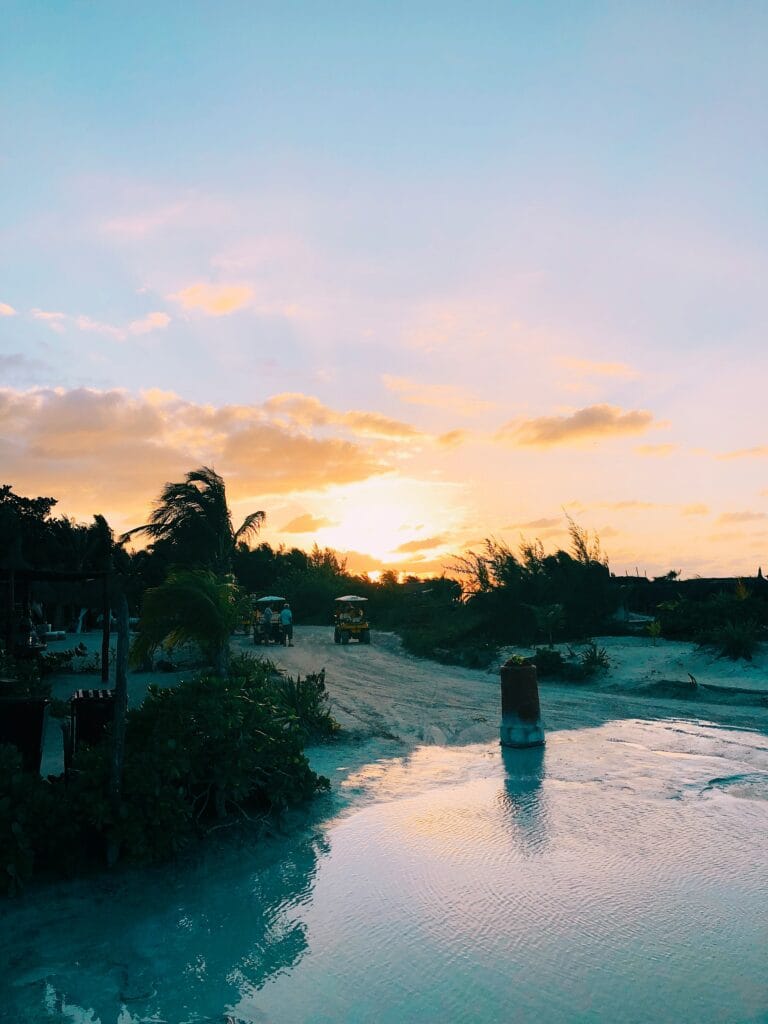
Protecting Paradise Through Community
Behind Holbox’s laid-back atmosphere lies a sophisticated understanding of sustainable development. The island community has created a model that other destinations study and attempt to replicate—balancing economic opportunity with environmental protection, welcoming visitors while preserving the qualities that make the place special.
Local organizations like Holbox Whale Shark work directly with fishing families to transition from traditional fishing to eco-tourism, providing training and certification that allows them to earn livelihoods while protecting marine ecosystems. Women’s cooperatives create and sell textiles that incorporate traditional Mayan techniques with contemporary designs, keeping cultural practices alive while generating income for families.
The island’s approach to development prioritizes community ownership over outside investment. Many of the hotels, restaurants, and tour operators are owned by families who have lived on Holbox for generations, ensuring that tourism revenue stays within the community and that business practices align with local values and environmental needs.
Planning Your Slow Island Escape
Reaching Holbox requires commitment—a two-hour drive from Cancún followed by a 20-minute ferry ride from the fishing village of Chiquilá. This journey serves as transition, gradually separating visitors from the mainland’s intensity and preparing them for island time.
The best visits happen during shoulder seasons—May through June and September through October—when the weather remains ideal but crowds thin considerably. Hurricane season (officially June through November) brings afternoon thunderstorms that create dramatic skies and cooler temperatures, though severe weather is relatively rare.
Accommodations range from family-run guesthouses where breakfast includes homemade tortillas and freshly caught fish to eco-luxury resorts that generate their own solar power and operate their own water treatment facilities. The key is choosing places that align with the island’s values—establishments that hire locally, source ingredients from the island and mainland Mexico, and contribute to conservation efforts.
Like many of Mexico’s once-hidden gems, Holbox is experiencing growing pains. Recent years have brought increased development, busier beach clubs, and a more pronounced party scene, particularly during peak season and weekends. The island that once offered complete tranquility now balances its traditional fishing village character with the realities of growing tourism demand.
This evolution makes timing and expectations even more important. Visiting during shoulder seasons, choosing accommodations away from the main beach strip, and seeking out family-run establishments can still provide access to the island’s authentic character, though the days of having pristine beaches entirely to yourself are increasingly rare.
The Gift of Holbox
Isla Holbox offers something increasingly precious in our hyperconnected world—the opportunity to live simply, authentically, and in harmony with natural rhythms. It’s a place where success is measured not in attractions visited or photos posted, but in moments of genuine connection—with place, with people, with the slower pace of living that allows us to notice details usually lost in the rush.
The island doesn’t try to be everything to everyone. It won’t satisfy visitors seeking nightclub scenes or all-inclusive convenience. Instead, it offers something more valuable—the chance to experience Mexico as it exists beyond the tourism industry’s manufactured experiences, in communities where traditions remain alive, where development serves residents rather than corporations, and where the natural world still dictates the rhythm of daily life.
For travelers ready to embrace uncertainty, to find joy in simplicity, and to discover that sometimes the most profound journeys happen when we stop trying to go everywhere and instead allow ourselves to be fully present somewhere, Holbox waits with open arms and endless horizons. Here, just beyond the tourist trail, time slows, bonds deepen, and the art of simple living reigns supreme.
